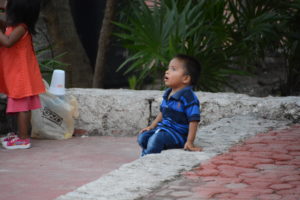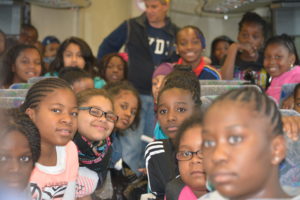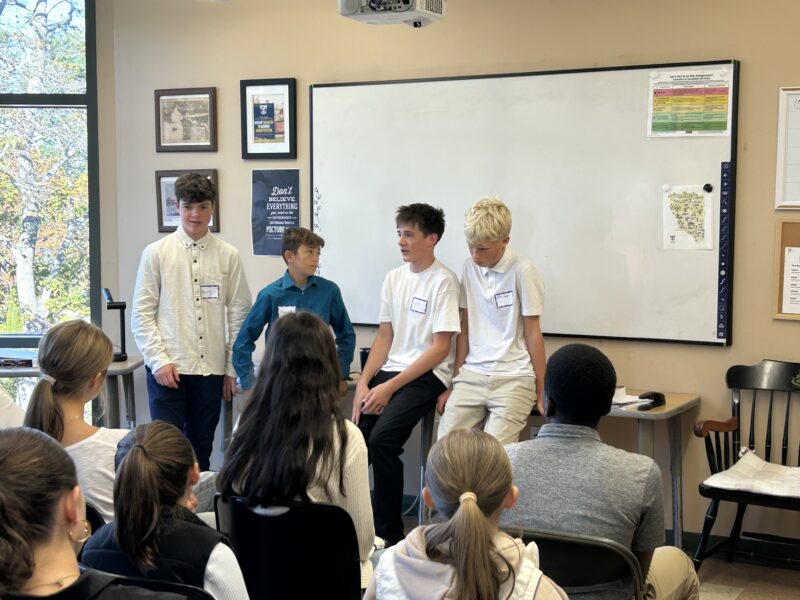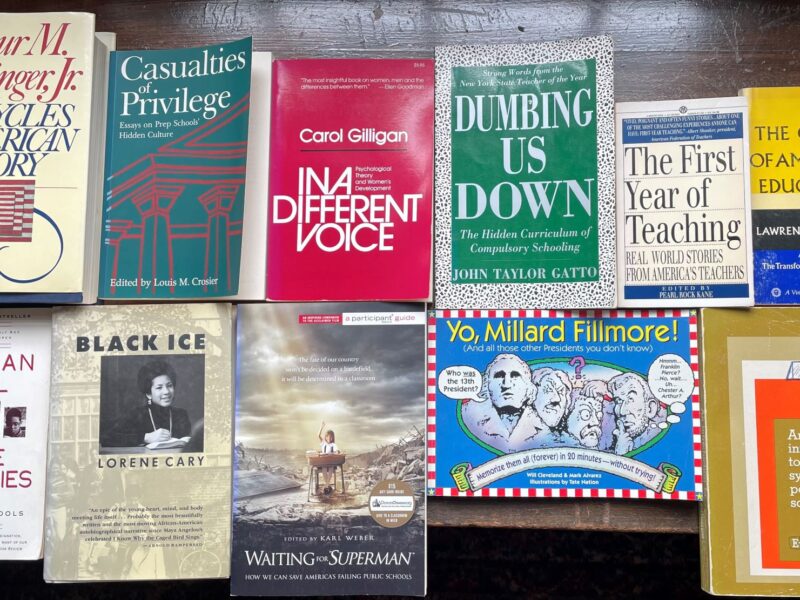The Coddling of the American Mind –
How Good Intentions and Bad Ideas are Setting Up a Generation for Failure
by Greg Lukianoff and Jonathan Haidt
“Prepare the child for the road, not the road for the child.” – Folk Wisdom

Educational reform has been an American “thing” for a long, long time. My memory goes back to New Math. Since then, it’s been quite the revolving door: Values Clarification… Summer Hill… Open Classrooms… Mainstreaming… Self-Pacing… Busing… Special Ed… Back-to-Basics… Bilingual… the evolving alphabet soup of Learning Differences (ADD, ADHD, ASD, ODD, etc.)… Experiential… A Nation at Risk… Merit Pay… No Child Left Behind… Anti-Bullying… Test-Mania (my word)… SEL… E-Learning…… (Whew!!!)
While there has been positive impact, count me among those who believe that the real solution to our educational ills lies more with families than with schools, more with parents than with teachers. I keep imagining what we might do if we could synchronize our homes with our schools, our parents with our teachers. This book gives me hope.

In fact, my spirits have been recently lifted by a double dose of Jonathan Haidt, an NYU social psychologist. After hearing him speak in Philadelphia in February, I read “Coddling.”
The book dissects what the authors call The Three Great Untruths (i.e., the “bad ideas” referenced in the sub-title):
- The Untruth of Fragility – What doesn’t kill you makes you weaker.
- The Untruth of Emotional Reasoning – Always trust your feelings.
- The Untruth of Us versus Them – Life is a battle between good people and evil people.

According to the authors, to qualify as an Untruth, an idea must:
- Contradict ancient wisdom (the ideas found in the customs, traditions, and literature of many cultures);
- Contradict modern psychological research on well-being (e.g., Cognitive Behavioral Therapy);
- Harm the individuals and communities who embrace it.
When Haidt started talking about fragility in Philadelphia, I naturally assumed that his fastball was going to be all about grit or resilience. Instead, he caught me with a curve ball that he calls Antifragile. He breaks down the distinctions:
– Fragile = easily broken and incapable of self-healing (e.g., a china tea cup)
– Resilient = can withstand shocks (plastic cups)
– Antifragile = require stressors and challenges in order to learn, adapt and grow (muscles, bones, children).
Anti-fragile entities become weak if they are not challenged, if they are not expected to respond vigorously to adverse circumstances. The authors explain, “Children are naturally antifragile, so overprotection makes them weaker and less resilient later on.”
Throughout the book, the authors utilize wind as a metaphor that can both extinguish a candle or energize a fire. They beseech us not to turn our children into candles!

The Untruth of Fragility, the authors argue, has taken root due to the rise of Safetyism, a mindset epitomized as such: “If we can prevent one child from getting hurt, we should deprive all children of slightly risky play.”
To illustrate fragility in kids, families, and schools, they cite examples such as playgrounds, conventional anti-bullying programs, and the decline of unsupervised play.
Contrasting “old school” playgrounds of the 50s and 60s with the soft, safe ones of today, Haidt says, “We need playgrounds where kids can get a little bit hurt. Because if you can’t get hurt, you can’t learn how to not get hurt! How can kids learn to assess risk if they never encounter risk?”
Being products of safetyism, most anti-bullying programs prohibit teasing and rough-housing, failing to perceive either as normal parts of growing up and necessary to antifragile development.
Advocating unsupervised play, the book refers to numerous studies comparing levels of parental supervision across different eras. Whereas it was common for Baby-Boomers to leave the house and wander unsupervised out into the neighborhood as early as age 6-8, the average for Generation Z (born after 1995) was age 12.

Safetyism has functioned hand-in-hand with “Paranoid Parenting,” a mindset that says, “good parents are expected to believe that their children are in danger every moment they are unsupervised.” To the authors’ view, it is ironic that this mindset has overtaken our country despite statistics consistently showing that the 1970s were much more dangerous than today in terms of child abductions and other personal crimes.

Once Generation Z left the schoolyard for college in 2013, safetyism followed. Psychologist Jean Twenge observed that they came with an expectation that “one should be safe not just from car accidents and sexual assault but from people who disagree with you.” This has led to a scarcity on many campuses of what the authors call viewpoint diversity.
Coddling portrays college as the place where the Untruths of Emotional Reasoning and Us versus Them kick in:
If a professor’s contrary political views make me feel unsafe… then I must be unsafe. (Emotional Reasoning)
Not only that, but anyone who would actually hold such views is a bad person. (Us vs. Them)
In short order, Generation Z sought safe spaces as havens from contrary speech. Some began keeping score in terms of professorial micro-aggressions. Observing this trend, the authors began to sense that “Students were beginning to demand protection from speech because they had unwittingly learned to employ the very cognitive distortions that CBT [Cognitive Behavioral Therapy] tries to correct. Stated simply: Many university students are learning to think in distorted ways, and this increases their likelihood of becoming fragile, anxious, and easily hurt.”
Returning to ancient wisdom as a guide, the authors observe, “The notion that a university should protect all of its students from ideas that some of them find offensive is a repudiation of the legacy of Socrates.” The authors cite several examples where scheduled campus speakers have been disinvited or even physically injured, many at some of America’s most prestigious colleges. They clearly believe that the current state of viewpoint diversity on today’s campuses thwarts the development of antifragility in our youth. (And lest the reader dismiss the authors as tools of the right, both identify themselves as liberals occupying different points on the left side of the political spectrum.)
Rather than simply curse the darkness of the predominantly liberal stance of contemporary college teaching faculties, the authors offer a concrete solution: consciously recruit and cultivate a 3-to-1 liberal-to-conservative ratio. They statistically show that colleges have historically been on the liberal side, but never to the extent that they are today. So, they reason, perhaps they should consciously strive to bring more balance to campus.
The authors move from the philosophical to the practical when they discuss the impact of cellphones and social media. During his talk in Philadelphia, Haidt focused on a five-year window:
– In 2006, Facebook opens to all ages.
– In 2007, the iPhone introduced.
– In 2009, the “Like” button added to Facebook.
– In 2010, Twitter and ReTweet option comes into play.
– By 2011, it all becomes toxic.
While parents and educators love to talk about how today’s kids are always on their phones, the authors back this up with voluminous statistics. Interestingly, Haidt points out that in 1976, of all the kids who had reached driving age, 90% had earned their license. Today, that number hovers around 50%. Kids would rather play with their devices than drive. (And besides, there’s always Uber!)

The authors show that this toxicity has been especially damaging to girls. Why girls and not boys (as much)? Because guys tend to use their devices for gaming, videos, and sports. Then they put them away. But girls tend to engage in never ending social media contact. Furthermore, even in those times when classes or extra-curricular activities might force them to put down their phones, their obsession with FOMO* and FOBLO prevents them from concentrating on tasks-at-hand. Meanwhile, social media outlets bombard them with artificial, unattainable body images.
“Wising Up,” the final section of the book, presents scores (literally!) of prescriptive tips, far too many to offer here. Some of these include:
- Assume that your kids are more capable this month than they were last month.
- Allow your kids to “dose themselves” with risk.
- Discourage the use of the word “safe” or “safety” for anything other than physical safety.
- Ban personal devices during the school day.
- Delay social media access until high school. (Middle schoolers should not be engaged in it, period.)
- In the interest of anti-fragile development, emphasize viewpoint diversity. Haidt and his team have established some websites to assist with this: HeterodoxAcademy.org… Open Mind.org… LetGrow.org.

Your kids are not candles. They can handle the road. This is an important book. Hope it becomes a bestseller!
Onward, Malcolm
* FOMO = Fear of Missing Out; FOBLO = Fear of Being Left Out



